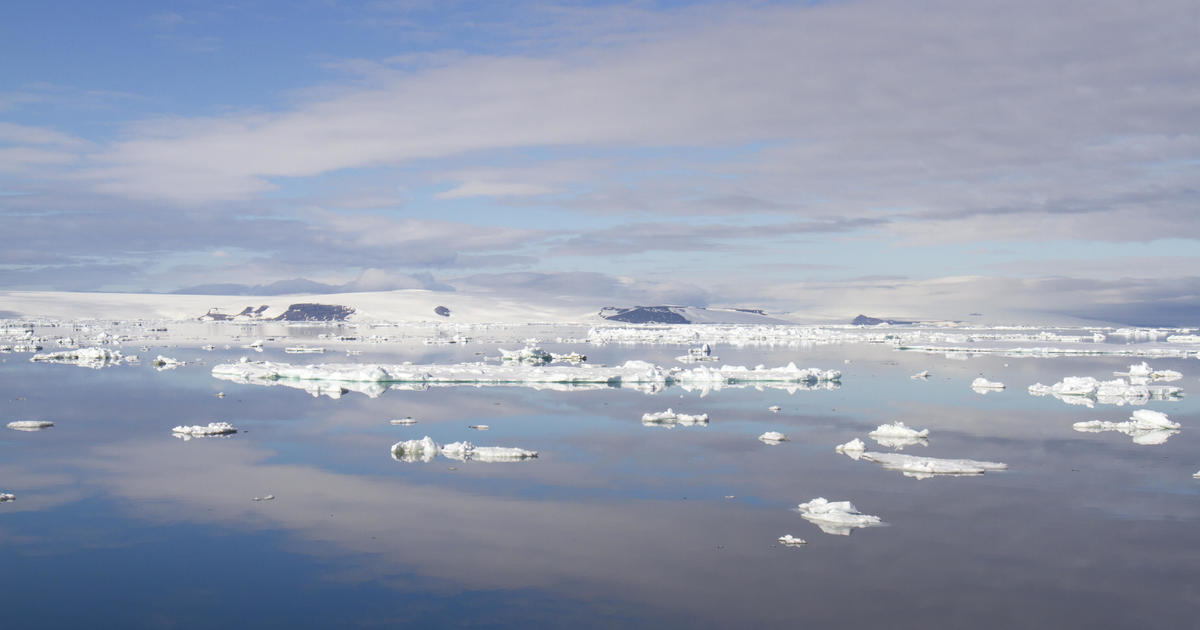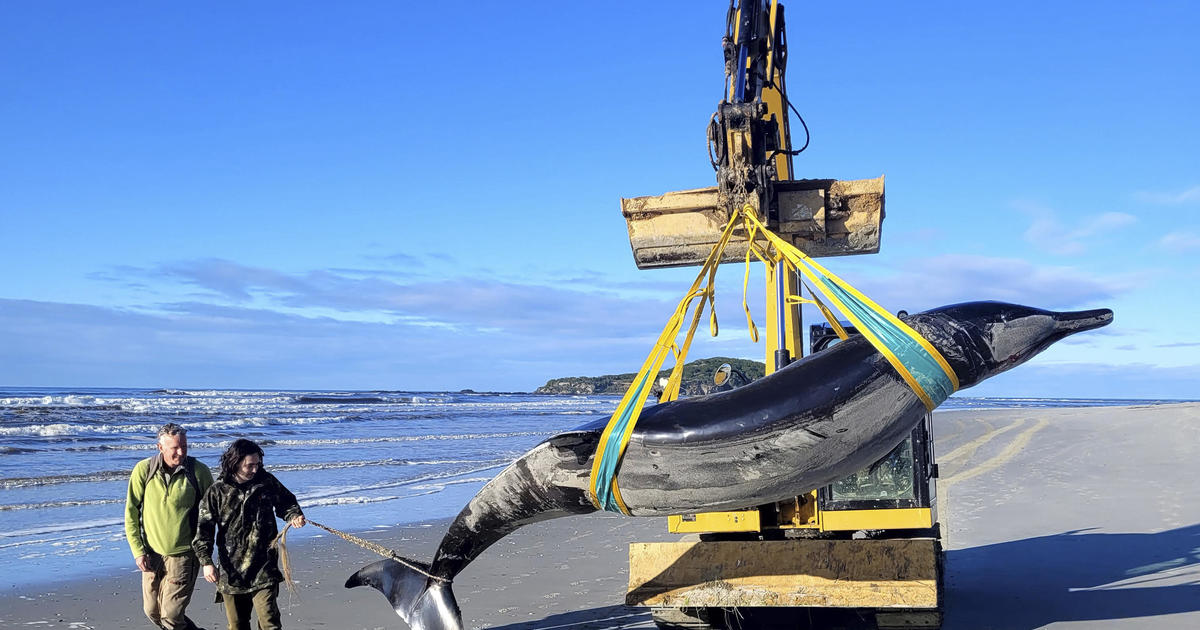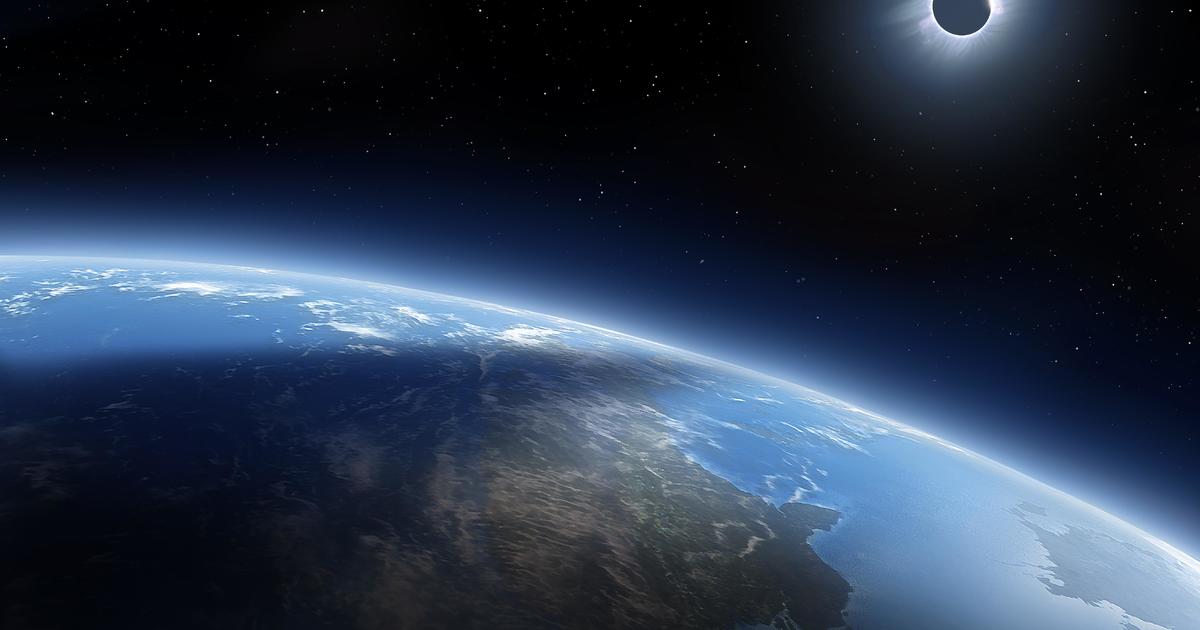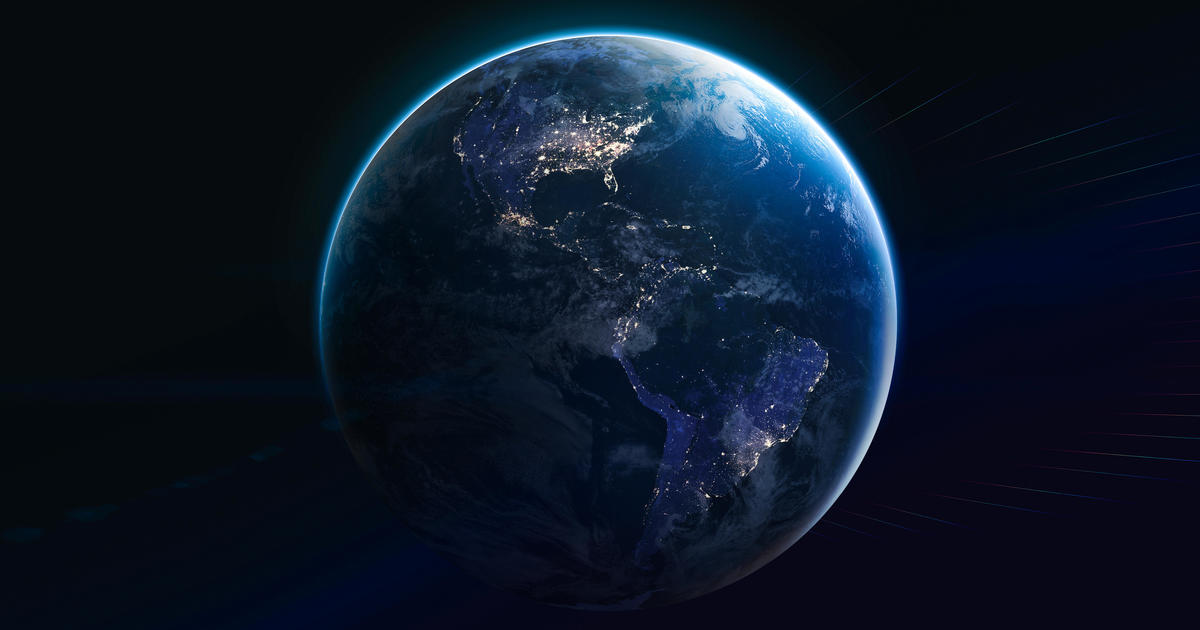Science & Environment
This power company has outpaced Nvidia, could ink next nuclear deal after Three Mile Island

Science & Environment
Antarctica’s “Doomsday Glacier” is set to retreat “further and faster,” scientists warn

The outlook for “Doomsday Glacier” just got gloomier.
Scientists are warning the Antarctic Ice Sheet, known formally as the Thwaites Glacier, will deteriorate “further and faster” and that sea level rise triggered by the melting could impact “hundreds of millions” in coastal communities.
“Towards the end of this century, or into the next century, it is very probable that we will see a rapid increase in the amount of ice coming off of Antarctica,” said Dr. Ted Scambos, a glaciologist at the University of Colorado. “The Thwaites is pretty much doomed.”
The findings are the culmination of six years of research conducted by the International Thwaites Glacier Collaboration, a collective of more than 100 scientists.
The “Doomsday Glacier,” roughly the size of the state of Florida, is one of the largest glaciers in the world. Scientists predict that its collapse could contribute to 65 centimeters, or roughly 26 inches in sea levels to rise.
The sea level rise could be even higher though if you account for the ice the Thwaites will draw in from the large surrounding glacial basins when it collapses. “That total will be closer to three meters of sea level rise,” Scambos said.
According to the researchers, the volume of water flowing into the sea from the Thwaites and its neighboring glaciers has doubled from the 1990s to the 2010s.
Approximately 1/3 of the front of the Twaites is currently covered by a thick plate of ice — an ice shelf — floating in the ocean that blocks ice from flowing into the sea. However, Scambos said the melting is accelerating and that the ice sheet is “very near to the point of breakup.”
“Probably within the next two or three years, it will break apart into some large icebergs,” he said. This will eventually leave the front of the glacier exposed. This may not necessarily lead to a sudden acceleration in melting, but it will change how the ocean interacts with the front of the ice shelf, Scambos said.
Deep ridges that prevent ice from flowing into the ocean are on their way out. The ridges, in the bedrock below the ice sheet in Antarctica, provide a “resistive force” against the ice, Scambos said, that slows down its flow into the ocean. As the Thwaites collapses, it will lose contact with these protective ridges, causing more ice to empty into the ocean.
One of the more surprising findings to come from the International Thwaites Glacier Collaboration was how tidal activity around the glacier is pumping warmer sea water into the ice sheet at high speed. That water, which is a couple of degrees above freezing, is getting trapped in parts of the glacier and forced further upstream.
“It goes in every day, it gets squashed up under the glacier. It completely melts whatever freshwater ice it can, and then it gets ejected, and then the whole thing starts again,” said Scambos.
The new findings from the International Thwaites Glacier Collaboration add to a vast body of research on how the deterioration of glaciers worldwide could contribute to sea level rise. In May, a study found that high-pressure ocean water is seeping beneath the “Doomsday Glacier” leading to a “vigorous ice melt.”
Study co-author Christine Dow called the Thwaites the “most unstable place in the Antarctic” and said the speed at which its melting could prove “devastating for coastal communities around the world.”
Researchers at the University of California, Irvine predicted the ocean could rise by about 60 centimeters, or about 23.6 inches, roughly on par with the predictions from scientists part of the International Thwaites Glacier Collaboration.
Scientists also have also warned about the potential consequences if the Greenland ice sheet were to melt. Greenland’s melting ice mass is now the No. 1 driver of sea level rise, according to Paul Bierman, a scientist at the University of Vermont. If it melts completely, scientists project it could lead to 20 to 25 feet of sea-level rise.
Rising global temperatures linked to climate change have made oceans warmed and generated new wind patterns that make these glaciers more susceptible to melting.
“It is very likely related to increasing greenhouse gasses in the atmosphere, which changed wind patterns around Antarctica, and therefore changed ocean circulation around Antarctica,” said Scambos. “That’s the main culprit.”
Scientists project that without intervention, the Thwaites could completely disappear by the 23rd century.
Science & Environment
Constellation Energy to restart Three Mile Island and sell the power to Microsoft

Norma Field walks under power lines coming off of the nuclear plant on Three Mile Island (TMI), with the operational plant run by Exelon Generation, in Middletown, Pennsylvania.
Andrew Caballero-Reynolds | AFP | Getty Images
Constellation Energy plans to restart the Three Mile Island nuclear plant and will sell the power to Microsoft, the companies announced on Friday.
Constellation expects the Unit 1 reactor at Three Mile Island to come back online in 2028, subject to approval by the Nuclear Regulatory Commission. Unit 1 ceased operations in 2019 because it could not compete economically. It is separate from the reactor that partially melted down in 1979 in the worst nuclear accident in U.S. history.
Microsoft will purchase electricity from the plant to match the energy its data centers consume with carbon-free power. Constellation described the agreement with Microsoft as the largest power purchase agreement that the nuclear plant operator has ever signed.
Constellation stock jumped nearly 7% in early trading.
This is breaking news. Please refresh for updates.
Science & Environment
Creature that washed up on New Zealand beach may be world’s rarest whale — a spade-toothed whale

Wellington, New Zealand — Spade-toothed whales are the world’s rarest, with no live sightings ever recorded. No one knows how many there are, what they eat, or even where they live in the vast expanse of the southern Pacific Ocean. However, scientists in New Zealand may have finally caught a break.
The country’s conservation agency said Monday a creature that washed up on a South Island beach this month is believed to be a spade-toothed whale. The five-meter-long creature, a type of beaked whale, was identified after it washed ashore on Otago beach from its color patterns and the shape of its skull, beak and teeth
“We know very little, practically nothing” about the creatures, Hannah Hendriks, Marine Technical Advisor for the Department of Conservation, told The Associated Press. “This is going to lead to some amazing science and world-first information.”
If the cetacean is confirmed to be the elusive spade-toothed whale, it would be the first specimen found in a state that would permit scientists to dissect it, allowing them to map the relationship of the whale to the few others of the species found and learn what it eats and perhaps lead to clues about where they live.
Only six other spade-toothed whales have ever been pinpointed, and those found intact on New Zealand’s North Island beaches had been buried before DNA testing could verify their identification, Hendriks said, thwarting any chance to study them.
This time, the beached whale was quickly transported to cold storage and researchers will work with local Māori iwi (tribes) to plan how it will be examined, the conservation agency said.
New Zealand’s Indigenous people consider whales a taonga – a sacred treasure – of cultural significance. In April, Pacific Indigenous leaders signed a treaty recognizing whales as “legal persons,” although such a declaration is not reflected in the laws of participating nations.
Nothing is currently known about the whales’ habitat. The creatures deep-dive for food and likely surface so rarely that it has been impossible to narrow their location further than the southern Pacific Ocean, home to some of the world’s deepest ocean trenches, Hendriks said.
“It’s very hard to do research on marine mammals if you don’t see them at sea,” she said. “It’s a bit of a needle in a haystack. You don’t know where to look.”
The conservation agency said the genetic testing to confirm the whale’s identification could take months.
It took “many years and a mammoth amount of effort by researchers and local people” to identify the “incredibly cryptic” mammals, Kirsten Young, a senior lecturer at the University of Exeter who has studied spade-toothed whales, said in emailed remarks.
The fresh discovery “makes me wonder – how many are out in the deep ocean and how do they live?” Young said.
The first spade-toothed whale bones were found in 1872 on New Zealand’s Pitt Island. Another discovery was made at an offshore island in the 1950s, and the bones of a third were found on Chile’s Robinson Crusoe Island in 1986. DNA sequencing in 2002 proved that all three specimens were of the same species – and that it was one distinct from other beaked whales.
Researchers studying the mammal couldn’t confirm if the species went extinct. Then in 2010, two whole spade-toothed whales, both dead, washed up on a New Zealand beach. Firstly mistaken for one of New Zealand’s 13 other more common types of beaked whale, tissue samples – taken after they were buried – revealed them as the enigmatic species.
New Zealand is a whale-stranding hotspot, with more than 5,000 episodes recorded since 1840, according to the Department of Conservation.
Science & Environment
Earth will get a second “mini-moon” for 2 months this year

Earth will get a second moon for about two months this year when a small asteroid begins to orbit our planet. The asteroid was discovered in August and is set to become a mini-moon, revolving around Earth in a horseshoe shape from Sept. 29 to Nov. 25.
Researchers at the Asteroid Terrestrial-impact Last Alert System, an asteroid monitoring system funded by NASA, spotted the asteroid using an instrument in Sutherland, South Africa and labeled it 2024 PT5.
Scientists from the Universidad Complutense de Madrid have tracked the asteroid’s orbit for 21 days and determined its future path. 2024 PT5 is from the Arjuna asteroid belt, which orbits the sun, according to their study published in Research Notes of the AAs.
But Earth’s gravitational pull will draw 2024 PT5 towards it and, much like our moon, it will orbit our planet — but only for 56.6 days.
While other non-Earth objects, or NEOs, have entered Earth’s orbit before, some don’t complete full revolutions of Earth. Some, however, do and become so-called mini-moons.
An asteroid called 2020 CD3 was bound to Earth for several years before leaving the planet’s orbit in 2020 and another called 2022 NX1 became a mini-moon of Earth in 1981 and 2022 and will return again in 2051.
2024 PT5, which is larger than some of the other mini-moons, will also return to Earth’s orbit — in 2055.
Earth’s gravity will pull it into its orbit and the asteroid will have negative geocentric energy, meaning it can’t escape Earth’s gravitational pull. It will orbit around Earth in a horseshoe shape before reverting back to heliocentric energy, meaning it will rotate around the sun again, like the other planets and NEOs in our galaxy.
Even after it leaves orbit, it will stay near Earth for a few months, making its closest approach on Jan. 9, 2025. Soon after, it will leave Earth’s neighborhood until its path puts it back into our orbit in about 30 years.
The study’s lead author Carlos de la Fuente Marcos told Space.com the mini-moon will be too small to see with amateur telescopes or binoculars but professional astronomers with stronger tools will be able to spot it.
CBS News has reached out to Marcos for further information and is awaiting response.
Science & Environment
Climate change is making days longer, according to new research

Climate change is making days longer, as the melting of glaciers and polar ice sheets causes water to move closer to the equator, fattening the planet and slowing its rotation, according to a recent study.
Research published in the Proceedings of the National Academy of Sciences used both observations and reconstructions to track variations of mass at Earth’s surface since 1900.
In the 20th century, researchers found that between 0.3 milliseconds per century and 1 millisecond per century were added to the length of a day by climate-induced increases. Since 2000, they found that number accelerated to 1.3 milliseconds per century.
“We can see our impact as humans on the whole Earth system, not just locally, like the rise in temperature, but really fundamentally, altering how it moves in space and rotates,” Benedikt Soja of ETH Zurich in Switzerland told Britain’s Guardian newspaper. “Due to our carbon emissions, we have done this in just 100 or 200 years, whereas the governing processes previously had been going on for billions of years. And that is striking.”
Researchers said that, under high greenhouse gas emission scenarios, the climate-induced increase in the length of a day will continue to grow and could reach a rate twice as large as the present one. This could have implications for a number of technologies humans rely on, like navigation.
“All the data centers that run the internet, communications and financial transactions, they are based on precise timing,” Soja said. “We also need a precise knowledge of time for navigation, and particularly for satellites and spacecraft.”
Science & Environment
The Buck Moon is almost here. Here’s when and where to see July’s full moon.

The next full moon is arriving just in time for the weekend. According to NASA, the Buck Moon will make an appearance for three days, from Friday evening to Monday morning, reaching its peak at 6:17 a.m. EDT on Sunday.
The moon is also known as the Thunder Moon, given its overlap with thunderstorm season.
NASA advised viewers to stay safe from the lightning that comes with the storms, but also to indulge in a little fun as the Buck Moon arrives: “As usual, the wearing of suitably celebratory celestial attire is encouraged in honor of the full Moon.”
Why is it called the Buck Moon?
The name stems from a tradition established by the Maine Farmers’ Almanac in the 1930s, according to NASA, when the publication started listing the names of full moons. The Algonquin tribes of the Northeast reportedly called this month’s moon the Buck Moon – a nod to the deer that emerge this time of year.
“Early summer is normally when the new antlers of buck deer push out of their foreheads in coatings of velvety fur,” NASA said.
Other monikers for July’s full moon include Thunder Moon, Asalha Puja, Guru Full Moon, Hay Moon. and Mead Moon.
When will the next full moon take place?
August’s full moon — known as the Sturgeon Moon, according to the almanac.com — will peak on Monday, Aug. 19. This will be the first supermoon of the year, which means it will appear brighter and larger than other full moons.
Another event for stargazers to look forward to is a meteor shower on Saturday, July 31. Those on the East Coast will have to rise early if they want to catch the spectacle of light. According to NASA, the best time to see the shower from Washington, D.C., will be around 2 a.m.
-

 Sport1 day ago
Sport1 day agoJoshua vs Dubois: Chris Eubank Jr says ‘AJ’ could beat Tyson Fury and any other heavyweight in the world
-

 News2 days ago
News2 days agoYou’re a Hypocrite, And So Am I
-

 Science & Environment1 day ago
Science & Environment1 day ago‘Running of the bulls’ festival crowds move like charged particles
-

 News1 day ago
News1 day agoIsrael strikes Lebanese targets as Hizbollah chief warns of ‘red lines’ crossed
-

 Science & Environment1 day ago
Science & Environment1 day agoQuantum ‘supersolid’ matter stirred using magnets
-

 CryptoCurrency1 day ago
CryptoCurrency1 day agoEthereum is a 'contrarian bet' into 2025, says Bitwise exec
-

 Science & Environment2 days ago
Science & Environment2 days agoSunlight-trapping device can generate temperatures over 1000°C
-

 CryptoCurrency1 day ago
CryptoCurrency1 day agoBitcoin miners steamrolled after electricity thefts, exchange ‘closure’ scam: Asia Express
-

 CryptoCurrency1 day ago
CryptoCurrency1 day agoCardano founder to meet Argentina president Javier Milei
-

 CryptoCurrency1 day ago
CryptoCurrency1 day agoDorsey’s ‘marketplace of algorithms’ could fix social media… so why hasn’t it?
-

 CryptoCurrency1 day ago
CryptoCurrency1 day agoLow users, sex predators kill Korean metaverses, 3AC sues Terra: Asia Express
-

 Sport1 day ago
Sport1 day agoUFC Edmonton fight card revealed, including Brandon Moreno vs. Amir Albazi headliner
-

 Technology1 day ago
Technology1 day agoiPhone 15 Pro Max Camera Review: Depth and Reach
-

 Science & Environment1 day ago
Science & Environment1 day agoHow one theory ties together everything we know about the universe
-

 Science & Environment2 days ago
Science & Environment2 days agoHow to unsnarl a tangle of threads, according to physics
-

 Science & Environment2 days ago
Science & Environment2 days agoHow to wrap your mind around the real multiverse
-

 Science & Environment2 days ago
Science & Environment2 days agoNuclear fusion experiment overcomes two key operating hurdles
-

 CryptoCurrency1 day ago
CryptoCurrency1 day agoCertiK Ventures discloses $45M investment plan to boost Web3
-

 CryptoCurrency1 day ago
CryptoCurrency1 day agoDZ Bank partners with Boerse Stuttgart for crypto trading
-

 CryptoCurrency1 day ago
CryptoCurrency1 day agoRedStone integrates first oracle price feeds on TON blockchain
-

 CryptoCurrency1 day ago
CryptoCurrency1 day agoBitcoin bulls target $64K BTC price hurdle as US stocks eye new record
-

 CryptoCurrency1 day ago
CryptoCurrency1 day agoSEC asks court for four months to produce documents for Coinbase
-

 CryptoCurrency1 day ago
CryptoCurrency1 day ago‘No matter how bad it gets, there’s a lot going on with NFTs’: 24 Hours of Art, NFT Creator
-

 CryptoCurrency1 day ago
CryptoCurrency1 day agoBlockdaemon mulls 2026 IPO: Report
-

 CryptoCurrency1 day ago
CryptoCurrency1 day agoCoinbase’s cbBTC surges to third-largest wrapped BTC token in just one week
-

 Politics3 days ago
Politics3 days agoTrump says he will meet with Indian Prime Minister Narendra Modi next week
-

 Science & Environment2 days ago
Science & Environment2 days agoWhy this is a golden age for life to thrive across the universe
-

 Science & Environment1 day ago
Science & Environment1 day agoHyperelastic gel is one of the stretchiest materials known to science
-

 Politics1 day ago
Politics1 day agoLabour MP urges UK government to nationalise Grangemouth refinery
-

 Science & Environment2 days ago
Science & Environment2 days agoMaxwell’s demon charges quantum batteries inside of a quantum computer
-

 News1 day ago
News1 day agoBrian Tyree Henry on voicing young Megatron, his love for villain roles
-

 Technology3 days ago
Technology3 days agoWould-be reality TV contestants ‘not looking real’
-

 Science & Environment2 days ago
Science & Environment2 days agoQuantum time travel: The experiment to ‘send a particle into the past’
-

 Science & Environment2 days ago
Science & Environment2 days agoPhysicists are grappling with their own reproducibility crisis
-

 CryptoCurrency1 day ago
CryptoCurrency1 day ago2 auditors miss $27M Penpie flaw, Pythia’s ‘claim rewards’ bug: Crypto-Sec
-

 CryptoCurrency1 day ago
CryptoCurrency1 day ago$12.1M fraud suspect with ‘new face’ arrested, crypto scam boiler rooms busted: Asia Express
-

 CryptoCurrency1 day ago
CryptoCurrency1 day ago‘Everything feels like it’s going to shit’: Peter McCormack reveals new podcast
-

 Science & Environment1 day ago
Science & Environment1 day agoUK spurns European invitation to join ITER nuclear fusion project
-

 Science & Environment1 day ago
Science & Environment1 day agoA tale of two mysteries: ghostly neutrinos and the proton decay puzzle
-

 CryptoCurrency1 day ago
CryptoCurrency1 day agoDecentraland X account hacked, phishing scam targets MANA airdrop
-

 CryptoCurrency1 day ago
CryptoCurrency1 day agoCZ and Binance face new lawsuit, RFK Jr suspends campaign, and more: Hodler’s Digest Aug. 18 – 24
-

 CryptoCurrency1 day ago
CryptoCurrency1 day agoBeat crypto airdrop bots, Illuvium’s new features coming, PGA Tour Rise: Web3 Gamer
-

 CryptoCurrency1 day ago
CryptoCurrency1 day agoMemecoins not the ‘right move’ for celebs, but DApps might be — Skale Labs CMO
-

 CryptoCurrency1 day ago
CryptoCurrency1 day agoTelegram bot Banana Gun’s users drained of over $1.9M
-

 CryptoCurrency1 day ago
CryptoCurrency1 day agoVonMises bought 60 CryptoPunks in a month before the price spiked: NFT Collector
-

 CryptoCurrency1 day ago
CryptoCurrency1 day agoVitalik tells Ethereum L2s ‘Stage 1 or GTFO’ — Who makes the cut?
-

 CryptoCurrency1 day ago
CryptoCurrency1 day agoEthereum falls to new 42-month low vs. Bitcoin — Bottom or more pain ahead?
-
Business1 day ago
How Labour donor’s largesse tarnished government’s squeaky clean image
-

 News1 day ago
News1 day agoChurch same-sex split affecting bishop appointments
-

 Technology1 day ago
Technology1 day agoFivetran targets data security by adding Hybrid Deployment
-

 Science & Environment2 days ago
Science & Environment2 days agoElon Musk’s SpaceX contracted to destroy retired space station
-
News1 day ago
Freed Between the Lines: Banned Books Week
-

 MMA1 day ago
MMA1 day agoUFC’s Cory Sandhagen says Deiveson Figueiredo turned down fight offer
-

 MMA1 day ago
MMA1 day agoDiego Lopes declines Movsar Evloev’s request to step in at UFC 307
-

 Football1 day ago
Football1 day agoNiamh Charles: Chelsea defender has successful shoulder surgery
-

 Football1 day ago
Football1 day agoSlot's midfield tweak key to Liverpool victory in Milan
-

 Science & Environment1 day ago
Science & Environment1 day agoThe physicist searching for quantum gravity in gravitational rainbows
-

 Science & Environment1 day ago
Science & Environment1 day agoHow to wrap your head around the most mind-bending theories of reality
-

 Technology3 days ago
Technology3 days agoCan technology fix the ‘broken’ concert ticketing system?
-

 Fashion Models1 day ago
Fashion Models1 day agoMiranda Kerr nude
-

 Fashion Models1 day ago
Fashion Models1 day ago“Playmate of the Year” magazine covers of Playboy from 1971–1980
-

 News4 days ago
News4 days agoDid the Pandemic Break Our Brains?
-

 Science & Environment1 day ago
Science & Environment1 day agoA new kind of experiment at the Large Hadron Collider could unravel quantum reality
-

 Science & Environment1 day ago
Science & Environment1 day agoHow Peter Higgs revealed the forces that hold the universe together
-

 Science & Environment1 day ago
Science & Environment1 day agoOdd quantum property may let us chill things closer to absolute zero
-

 Science & Environment2 days ago
Science & Environment2 days agoQuantum forces used to automatically assemble tiny device
-

 Science & Environment1 day ago
Science & Environment1 day agoRethinking space and time could let us do away with dark matter
-

 Science & Environment2 days ago
Science & Environment2 days agoITER: Is the world’s biggest fusion experiment dead after new delay to 2035?
-

 News3 days ago
News3 days agoItaly braces for rain as 21 killed in Europe floods
-
Business3 days ago
Glasgow to host scaled-back Commonwealth Games in 2026
-

 Science & Environment2 days ago
Science & Environment2 days agoLiquid crystals could improve quantum communication devices
-

 Science & Environment2 days ago
Science & Environment2 days agoX-ray laser fires most powerful pulse ever recorded
-

 Science & Environment2 days ago
Science & Environment2 days agoBeing in two places at once could make a quantum battery charge faster
-

 Science & Environment1 day ago
Science & Environment1 day agoWe may have spotted a parallel universe going backwards in time
-

 CryptoCurrency1 day ago
CryptoCurrency1 day agoArthur Hayes’ ‘sub $50K’ Bitcoin call, Mt. Gox CEO’s new exchange, and more: Hodler’s Digest, Sept. 1 – 7
-

 CryptoCurrency1 day ago
CryptoCurrency1 day agoTreason in Taiwan paid in Tether, East’s crypto exchange resurgence: Asia Express
-

 CryptoCurrency1 day ago
CryptoCurrency1 day agoLeaked Chainalysis video suggests Monero transactions may be traceable
-

 CryptoCurrency1 day ago
CryptoCurrency1 day agoJourneys: Robby Yung on Animoca’s Web3 investments, TON and the Mocaverse
-

 CryptoCurrency1 day ago
CryptoCurrency1 day agoLouisiana takes first crypto payment over Bitcoin Lightning
-

 CryptoCurrency1 day ago
CryptoCurrency1 day agoAre there ‘too many’ blockchains for gaming? Sui’s randomness feature: Web3 Gamer
-

 CryptoCurrency1 day ago
CryptoCurrency1 day agoCrypto whales like Humpy are gaming DAO votes — but there are solutions
-

 CryptoCurrency1 day ago
CryptoCurrency1 day agoHelp! My parents are addicted to Pi Network crypto tapper
-

 CryptoCurrency1 day ago
CryptoCurrency1 day agoCrypto scammers orchestrate massive hack on X but barely made $8K
-

 Science & Environment1 day ago
Science & Environment1 day agoA single atom could drive a piston in a quantum engine
-

 Science & Environment1 day ago
Science & Environment1 day agoTiny magnet could help measure gravity on the quantum scale
-

 Science & Environment1 day ago
Science & Environment1 day agoWhy we need to invoke philosophy to judge bizarre concepts in science
-

 Science & Environment1 day ago
Science & Environment1 day agoJupiter’s stormy surface replicated in lab
-

 Science & Environment1 day ago
Science & Environment1 day agoFuture of fusion: How the UK’s JET reactor paved the way for ITER
-

 CryptoCurrency1 day ago
CryptoCurrency1 day agoSEC sues ‘fake’ crypto exchanges in first action on pig butchering scams
-

 CryptoCurrency1 day ago
CryptoCurrency1 day agoFed rate cut may be politically motivated, will increase inflation: Arthur Hayes
-

 CryptoCurrency1 day ago
CryptoCurrency1 day agoBinance CEO says task force is working ‘across the clock’ to free exec in Nigeria
-

 CryptoCurrency1 day ago
CryptoCurrency1 day agoElon Musk is worth 100K followers: Yat Siu, X Hall of Flame
-

 CryptoCurrency1 day ago
CryptoCurrency1 day agoBitcoin price hits $62.6K as Fed 'crisis' move sparks US stocks warning
-

 CryptoCurrency1 day ago
CryptoCurrency1 day agoBitcoin bull rally far from over, MetaMask partners with Mastercard, and more: Hodler’s Digest Aug 11 – 17
-

 CryptoCurrency1 day ago
CryptoCurrency1 day ago‘Silly’ to shade Ethereum, the ‘Microsoft of blockchains’ — Bitwise exec
-

 CryptoCurrency1 day ago
CryptoCurrency1 day agoETH falls 6% amid Trump assassination attempt, looming rate cuts, ‘FUD’ wave
-
Business1 day ago
Thames Water seeks extension on debt terms to avoid renationalisation
-
Politics1 day ago
The Guardian view on 10 Downing Street: Labour risks losing the plot | Editorial
-

 Politics1 day ago
Politics1 day agoI’m in control, says Keir Starmer after Sue Gray pay leaks
-
Politics1 day ago
‘Appalling’ rows over Sue Gray must stop, senior ministers say | Sue Gray



You must be logged in to post a comment Login